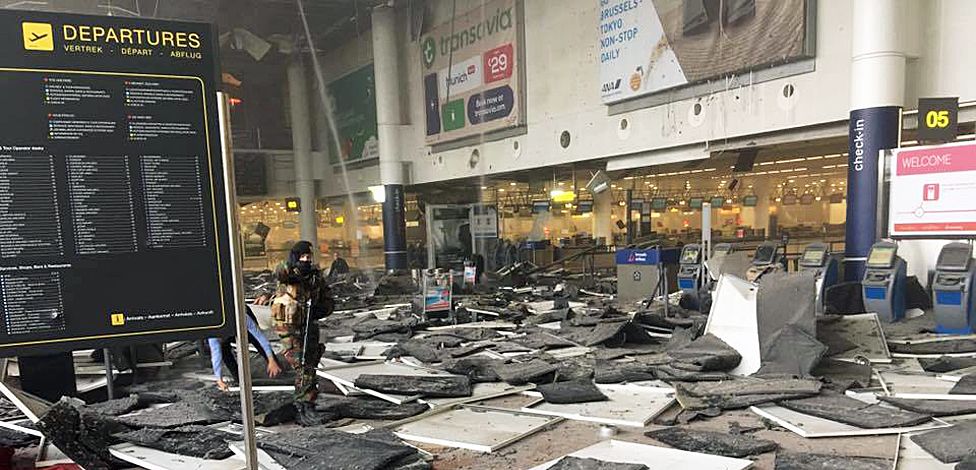
The terrorist attacks in Brussels – a brief analysis
Antecedents and timing
Prior to the terrorist attacks in Brussels on March 22nd, Belgian security forces had arrested Salah Abdeslam, one of the suspected coordinators of last November’s atrocities in Paris. Despite theories linking his arrest to the attacks in Brussels, so far nothing specific has been confirmed. It has been claimed that the attacks in Brussels could have been an immediate retaliation for Abdeslam’s arrest, or a response to Abdeslam’s supposed failure to fulfil his mission in Paris. The former theory, however, seems to be contradicted by the fact that the Brussels attacks were probably preceded by time-consuming preparations, as they were complex and well-coordinated in their execution. The more likely underlying cause may be that those within Abdeslam’s group feared detection, leading them to bring forward a larger attack which they had planned to carry out at Easter.
An overview of the Belgian jihadist scene
Belgium is part of the international coalition against ISIL, and has maintained the highest security alert since the attacks in Paris. The arrest of Abdeslam can be seen as a success for the law enforcement authorities, but uncovering a smaller jihadist network can only count as a partial success, since among Western countries Belgium still has the highest number of foreign fighters in Syria per capita: more than 500 have left for Syria and Iraq to join ISIL.[1] Brussels has become known as one of Europe’s major hotbeds for Islamist radicalisation; this is partly due to its high concentration of Islamist extremists and foreign fighters (for example, in the working-class district of Molenbeek, where there is an immigrant majority), but also due to its proximity to other European capitals. Further aggravating factors are Brussels’ decentralised public administration (including law enforcement), information sharing between the security agencies, the lack of adequate legislative tools to counter potential suspects of terrorist crimes, and the large flow of illegal weapons.
The modus operandi of the attacks
The selection of targets in Brussels (the Zaventem international airport and the city-centre metro station of Maelbeek near the EU Headquarters) likely serves as a demonstration of capability. After having selected mainly “soft” targets in Paris, the attacks were a demonstration of the ability to hit targets and critical infrastructure of strategic importance. The selection of the airport as a target may also be seen as a message directed towards the NATO Headquarters, located only five kilometres away. The NATO Headquarters in Brussels is the Alliance’s political and administrative centre, and home to its senior policy decision-making body. The attack at the subway station yet again shed light on the insufficient security surrounding EU institutions.
The reality of the war narrative
A significant part of the tactics used by ISIL is spreading chaos on the territories of the proclaimed enemy. Ever since the invasion of Iraq in 2003, European soil has been declared as a “land of war” by militant Islamists, where, according to the interpretation of Salafi jihadists, attacks against state institutions and civilians are permitted. Under this interpretation, since civilians are electors of the decision-makers, they can be held responsible for the decisions of their politicians. The spread of chaos as an act of war includes the execution of terrorist attacks, but it may also be realised through general public disorder – as in the wave of sexual assaults and robberies in Cologne and other European cities on New Year’s Eve. Such acts aim to create an atmosphere of fear, with paralysing and destabilising effects on the political and economic climate. Therefore the war narrative can no longer be ignored, even if its acceptance requires acknowledgment of the adversary’s logic.
The ISIL trap
ISIL’s theatres of operations in the Middle East and Europe are organically interwoven, as the ideology of the Islamic State calls for territorial expansion. Failure to achieve such expansion would expose the leaders as incompetent, and hence unfit to govern. Therefore opening several fronts of war is in the interest of ISIL, and for this purpose there are several reasons why Europe is a convenient battleground. These include the following: Europe’s proximity to the conflict in the Middle East; the current chaos caused by the ongoing migrant crisis; the potential supply of recruits from a population of young men of military age – migrants as well as second- and third-generation European Muslims; and human rights agendas in Europe which overrule the security agenda. In this trap-like situation, the most important step is to eradicate the Islamic State in Syria and Iraq – despite the fact that such action will very likely increase the number of terrorist assaults on European soil.
Migration and terrorism
Both ideologically and militarily, the current migrant waves and resultant large-scale influx of young men provide continuous communication and a source of recruits through the two-way “terror-corridor” which has linked Europe and the Middle East for at least the past ten years. Soldiers from the theatre of operations in the Middle East arrive in Europe to recuperate and provide military training, whilst young men from Western European countries travel to the conflict zone to gain practical experience on the battlefield. The return of the so-called foreign fighters represents a major threat to European security, as they return with enhanced capacity and potentially strengthened will to perform terrorist acts, as well as a lower threshold for the use violence. As “fighters” they enjoy a higher status within their groups of like-minded militant Islamists, and they can thereby easily recruit and radicalise others. With their enlarged international network of international jihadists, they are also able to provide help and logistical support to those wishing to join ISIL.
The poorly integrated immigrant communities as potential security risks
The radicalisers and educators (“the outsiders”) usually settle in local militant Islamist communities comprising mainly radicalised second- and third-generation Muslims (“the insiders”). Saleh Abdeslam clearly exemplifies the profile of a radicalised second-generation Muslim youth, who received training from radicalisers arriving in Belgium. He lived in the working-class, immigrant-majority suburb of Molenbeek in Brussels. The problems posed by disaffected and closed diaspora communities is also demonstrated by the fact that Abdeslam was able to hide in Molenbeek for almost four months following the Paris attacks. The infiltration of such communities is highly risky and time-consuming. The arms supply of the jihadist cells in Europe is maintained through the illegal arms trade. Part of the cash flow is supplied by the illegal trade in artefacts looted by the Islamic State in Syria, and through the lucrative smuggling of oil from Syrian territories. Finances are also boosted by a fairly new income stream generated by people-smuggling on the constantly changing migrant routes towards Europe.
The terrorist attacks in Brussels also show that arresting one or two members of a jihadist group does not affect the capabilities or the will to perform such attacks, as there are hundreds of like-minded individuals ready to take action. Abdeslam also has a group of supporters and followers, as demonstrated by the unrest which broke out after his arrest in Molenbeek, when local youths attacked Belgian security forces, thereby expressing support for their “hero”. The narrative of waging war against Europe finds a fertile breeding ground among disenfranchised young Muslims, whose radicalisation is facilitated by the active or tacit support of the diaspora communities.
The deficiencies in European decision-making
Europe is currently under attack on multiple fronts, with security policies and laws designed for peacetime failing utterly. Despite the fact that since the Paris attacks their highest security level has been in place, Belgian security and law enforcement services failed to prevent two coordinated terrorist attacks targeting critical infrastructure. The terrorist crimes experienced throughout 2015 have not led to a review of the European security agenda, which is urgent and necessary. Now perhaps more than ever, national security services need to be guaranteed access to the tools and finances needed to enable them to perform their duty. Enhanced cooperation among European security and intelligence services must be addressed swiftly, as far too frequently this, too, has been advocated without any noticeable results. However, information sharing among security forces on national level must also be revised and strengthened, as the Belgian case shows.
Foreign fighters returning from Syria and Iraq must be kept under closer surveillance, regardless of the fact that such a measure requires an increase in both financial and human resources. In this regard the capacity of potential transit countries must also be enhanced and secured. Because of the nature of the risk posed by home-grown extremism and terrorism, it is fair to assume that the structure and functions of Western European security services require substantial revision.
Another important security issue is that of access to airports. Security checks at the entrance points to landside areas have already been in place for several years in countries such as Israel, Russia and the United States. It is fair to assume that stricter security measures can be expected around European airports.
The danger posed by European citizens travelling to conflict zones to join terrorist organisations and then returning to their home countries must also be reflected in criminal codes at Member State level. Joining such groups for terrorist purposes must be coherently addressed by lawmakers across the European Union. The return of foreign fighters is one of the very greatest security threats to European societies. Consideration should also be given to matching the sanctions provided by criminal codes with sanctions against the peer groups and families of perpetrators. Where dual citizenship is held, such a sanction may be deprivation of nationality and potentially expulsion, as a deterrent to prospective followers. Member States also need to review their policies on the prevention of violent extremism and radicalisation. But these measures alone will not suffice: European migration and integration policies require urgent review, as another highly troubling fact is.
[1] International Center for the Study on Radicalisation and Political Violence (ICSR), 2015.
